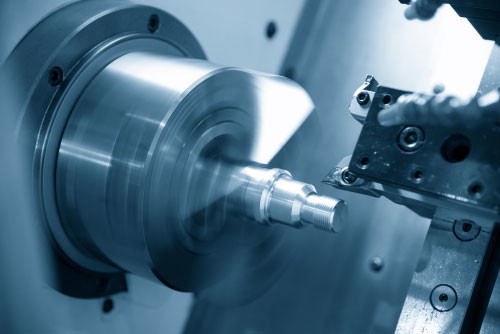CNC, or Computer Numeric Control, refers to the automation of machine tools, such as lathes and milling machines. Both machine types are used to cut material from a substrate in order to produce a desired shape with high accuracy and detail.
CNC turning and milling allows machinists the ability and freedom to create products with exceptionally complex features that would otherwise be impossible to achieve by hand.
The difference between CNC Turning and Milling
CNC turning spins a work piece in a machine, whilst single point cutting tools are moved parallel to the work piece. Material removal is performed by cutting perpendicular to the axis of rotation. The finished product is mostly round with cutting done on the inside and outside diameters.
CNC milling uses milling cutters, spinning at varying speeds, to remove material from the work piece. Cutting tools can be fed at any angle to the work piece, and follow a set cutting pattern developed by a programmer using dedicated programming software.
Differences between CNC turning and milling can be grouped as follows:
Machine Setup
Cutting Tools
Programming
Machine Setup
A CNC controlled lathe or turning centre is used for CNC turning. The material stock is normally round, but can also have irregular shapes like hexagons or squares. The material is held horizontally or vertically in a “chuck” that is also used to spin the work piece at varying speed. The speed will be determined by many factors including the diameter of the workpiece, material, type of cut made and type of cutter used.
A CNC controlled milling machine is used for CNC milling. The workpiece can be any shape as long as it can be securely held in the machine. In CNC milling, the cutting tool is spinning whilst the work piece generally remains in one spot. As with CNC turning, the workpiece can be held horizontally or vertically. However, complex 5 axis machines have the ability to move the work piece in multiple directions, allowing the cutting of features at many angles into the workpiece.
Cutting Tools
An insert cutter is used to remove material from a workpiece in CNC turning. It consists of a removable cutting tip made of carbide that is secured in a holder or boring bar. Cutting tools are grouped into two categories: tools for external cutting and tools for internal cutting. External cuts are made to the outside diameter of the work piece and is done using a holder, and internal cuts are made to the inside diameter of a workpiece and is done using a boring bar.
A milling tool is used to remove material from a workpiece in CNC milling operations. Milling tools are grouped into two categories: end mills and face mills. End mills are used to cut slots, bore holes or mill side faces of work pieces. Face mills are used for machining workpiece surfaces.





